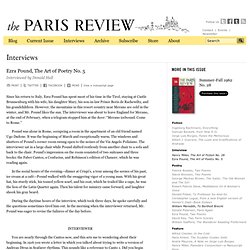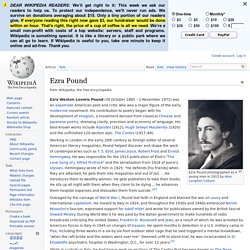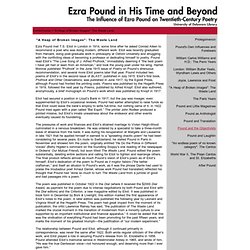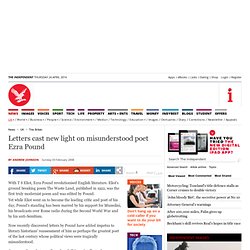

5, Ezra Pound. Since his return to Italy, Ezra Pound has spent most of his time in the Tirol, staying at Castle Brunnenburg with his wife, his daughter Mary, his son-in-law Prince Boris de Rachewiltz, and his grandchildren.

However, the mountains in this resort country near Merano are cold in the winter, and Mr. Pound likes the sun. The interviewer was about to leave England for Merano, at the end of February, when a telegram stopped him at the door: “Merano icebound. Come to Rome.” Pound was alone in Rome, occupying a room in the apartment of an old friend named Ugo Dadone. In the social hours of the evening—dinner at Crispi’s, a tour among the scenes of his past, ice cream at a café—Pound walked with the swaggering vigor of a young man. During the daytime hours of the interview, which took three days, he spoke carefully and the questions sometimes tired him out. You are nearly through the Cantos now, and this sets me to wondering about their beginning. Ezra Pound 1945 - Mugshot. Ezra Pound. Ezra Weston Loomis Pound (30 October 1885 – 1 November 1972) was an expatriate American poet and critic who was a major figure of the early modernist movement.

His contribution to poetry began with his development of Imagism, a movement derived from classical Chinese and Japanese poetry, stressing clarity, precision and economy of language. His best-known works include Ripostes (1912), Hugh Selwyn Mauberley (1920) and the unfinished 120-section epic, The Cantos (1917–69). Outraged by the carnage of World War I, Pound lost faith in England and blamed the war on usury and international capitalism. Ezra Pound and T S Eliot. Ezra Pound - Meeting T S Eliot.
Ezra Pound met T.S.

Eliot in London in 1914, some time after he asked Conrad Aiken to recommend a poet who was doing modern, different work. Eliot was recently graduated from Harvard, doing post-graduate work in philosophy at Oxford University and struggling with the conflicting ideas of becoming a professor or dedicating himself to poetry. Pound read Eliot’s “The Love Song of J. Alfred Prufrock,” immediately deeming it “the best poem I have yet had or seen from an American,” and took the young poet under his wing. Harriet Monroe published “Prufrock” in the June 1915 issue of Poetry on Pound’s strenuous recommendation, and several more Eliot poems later that year. Eliot had secured a position in Lloyd’s Bank in 1917, but the pay was meager, even supplemented by Eliot’s occasional reviews. The pressures of work and finances and Eliot’s strained marriage to Vivien Haigh-Wood culminated in a nervous breakdown.
T.S. Poems. The Waste Land. Newspaper - Pound's letters. Yet while Eliot went on to become the leading critic and poet of his day, Pound's standing has been marred by his support for Mussolini, his broadcasts over Rome radio during the Second World War and by his anti-Semitism.

Now recently discovered letters by Pound have added impetus to literary historians' reassessment of him as perhaps the greatest poet of the last century whose political views were tragically misunderstood. Correspondence between Pound and Chinese intellectuals over a period of more than 40 years – Pound had become fascinated with the country – will shed new light on his greatest work, The Cantos, and on his true political beliefs when they are published for the first time later this month.
They show his painstaking efforts to learn Chinese and incorporate his learning into The Cantos and also document his move away from fascism and towards Confucianism. The correspondence also sheds new light on his relationship with Eliot, who was also his publisher at Faber & Faber. Pound on Eliot (letters) Ezra Pound and T S Eliot.